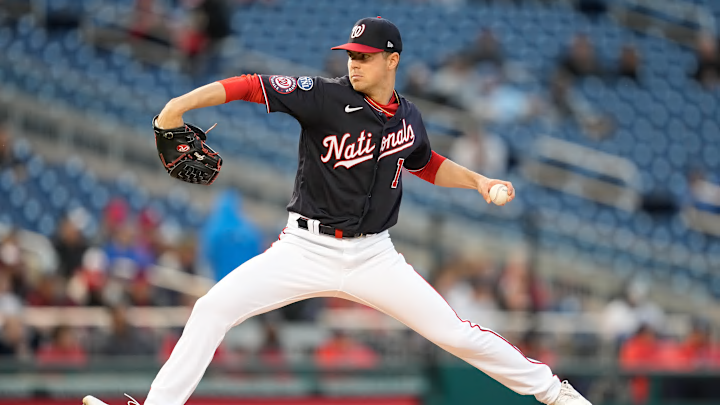When the Nationals acquired left-handed starting pitcher MacKenzie Gore in the trade that sent Juan Soto to San Diego, the expectations set for him were immediately - and understandably - extremely high.
For a team that had won the World Series three seasons prior, backed in large part by one of the best trios of starting pitchers in the league, the rotation had become startlingly subpar very quickly. Max Scherzer is a Met now, Stephen Strasburg has sparingly been healthy, and Patrick Corbin has been barely a shell of his 2019 self since that season.
Thoughts surrounding Gore were mixed when the trade was announced. At the time, Gore was battling elbow inflammation in his throwing arm, in a rookie season with the Padres that featured a stretch of dominance before significant struggles in the early summer months. He wound upon not pitching for Washington in 2022, and opinions became increasingly polarizing.
For those that waited through the period of unsubstantiated promises about his ability, the delay has been very worth the wait. Although he's delivered mixed results, he's performed as a middle of the rotation starter - which is all that realistically could've been asked of the 24 year old.
Admittedly, Gore had his worst outing of the season on Monday night. Still, while he's a bit inconsistent from batter to batter, there's nothing to be particularly discouraged about.
Through Gore's first six starts with the Nationals, he has an ERA of 3.77 with a 1.42 WHIP, 39 strikeouts and 18 walks through 31 innings. His worst metric, in that respect, is his walk rate of 5.2 per nine innings. Even with an impressive 11.3 strikeouts per nine innings, he's averaging barely more than two strikeouts per walk - a sign that even though he's almost unhittable, he lacks overall command of his arsenal of pitches.
MacKenzie Gore this season for the Nats
— Quinn Riley (@QuinnRileyTN) May 2, 2023
3.77 ERA
3.59 xFIP
4.21 SIERA
11.32 K/9
13.2 SwStr%
29.7 CSW%
5.3 Barrel% (72nd%)
.308 xwOBA (57th%)
.339 xSLG (73rd%)
His curveball also has a .147 xBA and a 43.1 Whiff%
pic.twitter.com/cQypuzprS0
Gore's hit or miss performance is further highlighted by his Baseball Savant profile. By the site's evaluation, Gore ranks in the top half of the league in all metrics related to how well or frequently he gets hit, including the top 20 percent of the league in strikeout rate and whiff rate, but in the bottom 15 percent in walk rate.
Gore's fastball, a four-seamer that sits at 95 miles per hour, has returned solid results. More than 60 percent of his pitches have been heaters, and they've returned an expected run value of exactly zero. His curveball and slider have been slightly negative, whereas his changeup - which he's only thrown seven times - has been is lone positive pitch, with an expected run value of 11.4 per 100 pitches.
Considering his arsenal is almost universally below average in terms of vertical and horizontal break (a.k.a., the "movement" that makes pitches hard for hitters to locate), it's impressive that he's had so much success with each of them. If Gore can add some movement to a couple pitches over time, he'll presumably improve as a pitcher - perhaps by a substantial margin.
Most promisingly, he's improved in every measurable area since last season. The velocity on his pitches has increased across the board, and hitters are having less success against them - including a "sweet spot" rate that has decreased by more than 11 percent.
Gore's strikeout and whiff rates have improved by between 6 and 7 percent respectively, and even his walk rate - his most troubling area this season - is 1.6 percent better than last year.
This all comes with the caveat that this, once again, is only a six start sample size. That's too few to jump to any sweeping conclusions from. Nonetheless, it's what the entire Nationals organization wanted to see from the southpaw.
All told, Gore hasn't been particularly good or bad this season, but he's become a better pitcher than he was as a rookie. Still, it's clear to see where he can improve - and none of it seems to be between the ears, considering the confidence he carries himself with.
Gore won't be arbitration eligible until after next season, and he'll be under club control through 2028 - just like Josiah Gray, the first player of our profile series.
Josiah last night: 7 Ks through 4 innings
— Washington Nationals (@Nationals) April 27, 2023
MacKenzie tonight: 7 Ks through 4 innings pic.twitter.com/IKRZLMvJ8P
Buy your MacKenzie Gore stock now, because by this time in a year or two, there's a chance that he's a real ace starting pitcher Perhaps next year he, Gray and Cade Cavalli (one of Washington's top five prospects who will be returning from thoracic outlet surgery) will be a respectable starting trio, bringing back memories of past Nationals teams.
